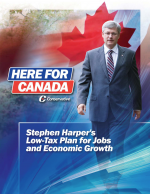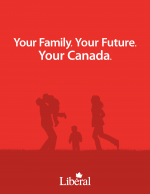Now that all the platforms are in, we thought it would be helpful to provide a summary of where the five major parties stand on the key question of pricing greenhouse gas pollution.
Before diving in, it's worth explaining why we see carbon pricing as such as central element of an effective climate plan for Canada. (If you're already convinced of the need to price emissions, you may want to jump ahead to the section below, entitled "Where the parties stand".)
In most of Canada right now, there is no fee of any kind attached to emitting greenhouse gas pollution. But that pollution causes climate change, which is already imposing costs on Canada and the world — and which is projected to cause much more serious harm unless we can significantly reduce our emissions.
A price on emissions helps to:
- Change economic decision-making so that polluters make cleaner choices. If pollution costs money, companies and individuals will find ways to produce less of it. And if companies have to pay the real costs of polluting technologies, it makes clean options cheaper by comparison, and thus more competitive.
- Find the lowest-cost ways to reduce emissions. Rather than governments deciding which technologies we should or shouldn't choose, carbon pricing lets markets find innovative solutions. Government of Canada analysis shows that a broad-based carbon price would be the cheapest way to meet Canada's greenhouse gas emission targets.
- Transfer the costs of climate change from all citizens to polluters. This lines up with the environmental principle of "polluter pays."
The two main ways to put a price on greenhouse gas pollution are through cap-and-trade systems or through a tax on carbon. In our view, both options can work, but they have to be designed well to do so.
In looking at a government's carbon pricing proposal, we would use a full set of criteria (including start date, breadth of coverage of emissions, limits on the use of offset credits or other flexibility provisions, administrative simplicity, use of revenues, and adequacy of carbon price) to assess its likely effectiveness.
Election platforms usually don't provide that level of detail, but we can make a rough comparison of the strengths and weaknesses of parties' proposed approaches from the plans they have released.
Where the parties stand
 Let's start with the easiest one, the Conservative Party. The Conservative Party does not currently support carbon pricing, as Environment Minister Peter Kent confirmed in a recent media interview. The Conservative party's opposition to carbon pricing leaves a gaping hole in their climate change plans, and would make it very difficult to meet the 2020 target they have chosen.
Let's start with the easiest one, the Conservative Party. The Conservative Party does not currently support carbon pricing, as Environment Minister Peter Kent confirmed in a recent media interview. The Conservative party's opposition to carbon pricing leaves a gaping hole in their climate change plans, and would make it very difficult to meet the 2020 target they have chosen.
Indeed, the Conservative platform even failed to mention the party's preferred alternative to carbon pricing, which is to impose emission regulations on Canada's industrial sectors. (However, a subsequent news release clarified that the party's plan consists of "targeted and common sense regulation of industries by sector.") As we discussed in an earlier blog post, economic analysis shows that choosing command-and-control regulations over carbon pricing is a less efficient, more expensive route to reducing Canada's emissions.
Each of the other four parties does support carbon pricing.
 The Liberal Party platform commits to "establish a cap-and-trade system" and to auction allowances under that system to companies. The system will apply to "all sectors of the economy without exception" and be "equitable" across all of Canada's regions. In a subsequent clarification, Alberta Liberal Senator Grant Mitchell explained that auction revenues raised in a given province would be returned there, to be invested "through partnerships with the province and industry in technologies and science to reduce greenhouse gas emissions and ensure the protection of water."
The Liberal Party platform commits to "establish a cap-and-trade system" and to auction allowances under that system to companies. The system will apply to "all sectors of the economy without exception" and be "equitable" across all of Canada's regions. In a subsequent clarification, Alberta Liberal Senator Grant Mitchell explained that auction revenues raised in a given province would be returned there, to be invested "through partnerships with the province and industry in technologies and science to reduce greenhouse gas emissions and ensure the protection of water."
- Strengths: Auctioning allowances is a design feature we support. We also advocate for re-investing some carbon pricing revenues in further emission reductions, and the Liberal Party's regional policy commits to do that. In addition, the decision to apply the system to all sectors "without exception" could mean that the Liberal party supports a broad-based cap-and-trade system — one that covers not just industrial emissions but the transportation sector too. Again, that's a policy direction we support.
- Weaknesses: The Liberal policy doesn't answer some fundamental questions, including: When will the system go into effect? What level of emission reduction does it aim to make? How many allowances will be auctioned? It's concerning that the platform's two-year budget plan doesn't book any revenues from carbon pricing, which raises the prospect that the system wouldn't go into effect for two years (or, alternately, that the system wouldn't auction any allowances in its first two years).
 The NDP platform also commits to auction allowances under its cap-and-trade system. But unlike the Liberal party, the NDP's costing document shows cap-and-trade revenues as early as 2011 (for a total of $3.6 billion dollars), with revenues increasing to $7.4 billion in 2014-15. The funds are to be spent "equitably across Canada into investments in green technologies, businesses and household energy conservation, public transit, support to renewable energy development, and transitioning workers to the green economy," and the costing document has 16 separate line items under "green initiatives."
The NDP platform also commits to auction allowances under its cap-and-trade system. But unlike the Liberal party, the NDP's costing document shows cap-and-trade revenues as early as 2011 (for a total of $3.6 billion dollars), with revenues increasing to $7.4 billion in 2014-15. The funds are to be spent "equitably across Canada into investments in green technologies, businesses and household energy conservation, public transit, support to renewable energy development, and transitioning workers to the green economy," and the costing document has 16 separate line items under "green initiatives."
- Strengths: The NDP platform would see Canada adopt a cap-and-trade system in 2011 and devote the auction proceeds to green initiatives. According to party officials, the $3.6 billion dollars is based on an initial auction rate of 22.5% of allowances, with a price floor of $45/tonne. Economic modelling analysis we published in 2009 shows that a price of $40/tonne starting in 2011 would get Canada on track to reach the government's 2020 target.
- Weaknesses: The platform says that the carbon price will apply to "Canada's biggest polluters," which means the system is likely to cover just half of Canada's emissions. (A broad-based cap-and-trade system could instead cover about 80% of Canada's emissions.) Like the Liberal platform, the NDP proposes a process to determine a 2020 target rather than committing to a specific goal. As a result, the NDP's platform does not specify what contribution the cap-and-trade system would make to meeting a 2020 goal.
 The Bloc Québécois platform does endorse a specific 2020 target (25 per cent below the 1990 level) based on scientific assessments of the contribution a developed country like Canada would need to make to avoiding dangerous climate change. However, in other areas their cap-and-trade proposals are fairly vague: the Bloc supports absolute caps on emissions (a pre-condition for a cap-and-trade system) and a carbon exchange in Montreal, along with financial penalties for companies that don't meet their targets.
The Bloc Québécois platform does endorse a specific 2020 target (25 per cent below the 1990 level) based on scientific assessments of the contribution a developed country like Canada would need to make to avoiding dangerous climate change. However, in other areas their cap-and-trade proposals are fairly vague: the Bloc supports absolute caps on emissions (a pre-condition for a cap-and-trade system) and a carbon exchange in Montreal, along with financial penalties for companies that don't meet their targets.
- Strengths: An ambitious 2020 target and a clear commitment to carbon trading.
- Weaknesses: The platform lacks details about the start date of the Bloc's preferred system; its level of stringency; which sectors would be covered and whether it would include an auction of emission allowances.
 Finally, the Green Party's full platform shows the most enthusiastic support for carbon pricing, supporting both a broad-based tax on greenhouse gas pollution starting at $50/tonne and a cap-and-trade system for heavy industry. The carbon tax is designed to be revenue-neutral, meaning that the taxes that an average family would pay will remain the same; the Green Party plans to use the $34 billion this initiative is estimated to raise in 2011-12 to reduce other taxes, provide a carbon rebate, and implement income splitting. (While the party is not proposing to spend carbon tax revenues on further emissions reductions, their platform does provide for increased spending on a range of clean energy programs funded from other sources.) The party also has a clear 2020 target even stronger than the Bloc's, at 30 per cent below the 1990 level in 2020.
Finally, the Green Party's full platform shows the most enthusiastic support for carbon pricing, supporting both a broad-based tax on greenhouse gas pollution starting at $50/tonne and a cap-and-trade system for heavy industry. The carbon tax is designed to be revenue-neutral, meaning that the taxes that an average family would pay will remain the same; the Green Party plans to use the $34 billion this initiative is estimated to raise in 2011-12 to reduce other taxes, provide a carbon rebate, and implement income splitting. (While the party is not proposing to spend carbon tax revenues on further emissions reductions, their platform does provide for increased spending on a range of clean energy programs funded from other sources.) The party also has a clear 2020 target even stronger than the Bloc's, at 30 per cent below the 1990 level in 2020.
With commitments like that, it's pretty hard to find weaknesses — although our assessment of the Green Party's platform did have some suggestions to make on effectively targeting the party's clean energy spending.






